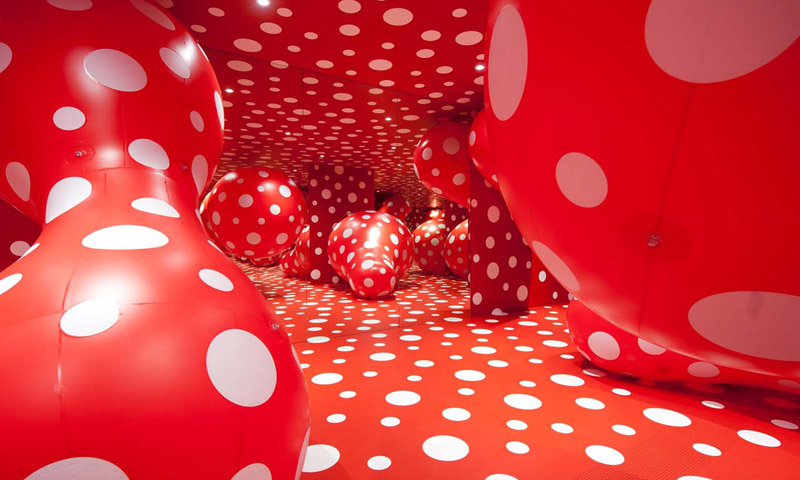DOTS OBSESSION
Yayoi Kusama’s ‘Dots Obsession’ series of installations reconfigures her trademark polka dots and mirrors — along with huge, amorphous inflatable objects — in response to specific sites. As with Reach Up to the Universe, Dotted Pumpkin 2011, reflection is presented in two modes: formally, in the continuity of the balloons’ red-and-white polka-dot pattern on the gallery walls, floor and ceiling, and in the infinite effect created by floor-to-ceiling mirrors. Both installations incorporate the viewer as a crucial element.
Dots Obsession visually approximates the hallucinations Kusama reportedly suffered as a child, in which the entirety of her surrounding space was covered with repeating patterns. The installation also reveals the artist’s careful attention to the construction of space through colour and form, and to the play of light and perspective accomplished by repeating a few simple devices — creating an immersive experience from red paint, white dots, giant balloons and strategically placed mirrors.
Kusama first explored installation in her 1963 solo exhibition ‘Aggregation: One Thousand Boats Show’ at Gertrude Stein Gallery in New York. Her innovation lay in configuring the entire exhibition as a single work, which consisted of one of her ‘Accumulation’ sculptures — a rowboat, covered in soft, phallic protuberances — presented in a space, the walls of which were covered in 999 reproductions of a photograph of the same sculpture. This proposed that the exhibition was not strictly for curators or gallerists to construct; it was now also a medium available to artists.
Her 1965 installation Infinity Mirror Room – Phalli’s Field was the first to combine the polka dots and mirrors that would later become her trademark motifs. The room consisted of four mirrored walls and a mirrored ceiling which infinitely reflected the mass of spotted protuberances covering the floor. Here, the repetition and reproducible nature of the object proposed in her 1963 installation was achieved through light and mirrors, creating the illusion of infinite space within a confined area. The vast field of phallic shapes this produced was, for Kusama, a manifestation of her fear of sex at the time. That the objects were covered in polka dots linked the anxiety to her childhood trauma, so the work can also be read as a means of therapy, of confronting a fear by representing it on a grand scale.
By the late 1960s, the polka dots had developed into a strategy of what the artist described as ‘self-obliteration’. A prominent feature of her ‘happenings’ and performances of the period, and usually daubed onto the bodies of participants, they symbolically neutralised the ego, which Kusama blamed for the horror and destruction of the US–Vietnam War. She urged at the time:
Obliterate your personality with polka dots. Become one with eternity. Become part of your environment. Take off your clothes. Forget yourself. Make love. Self-destruction is the only way to peace.

